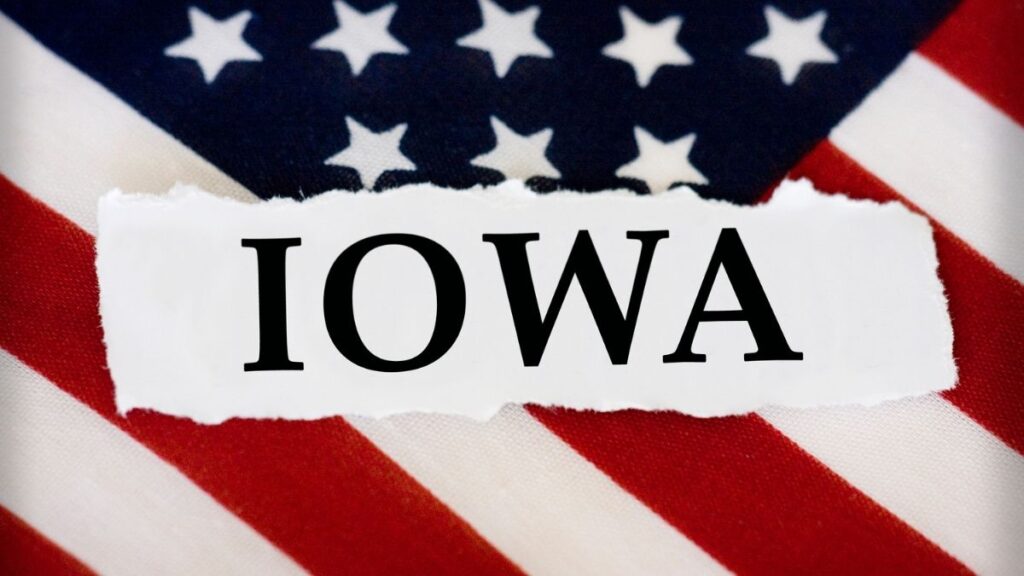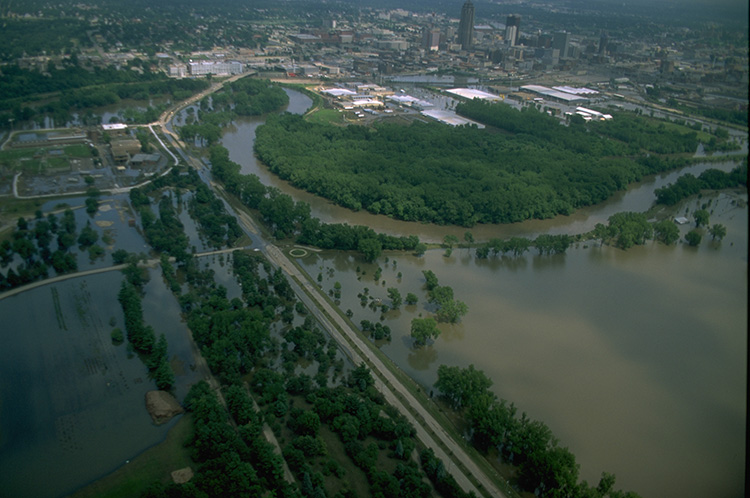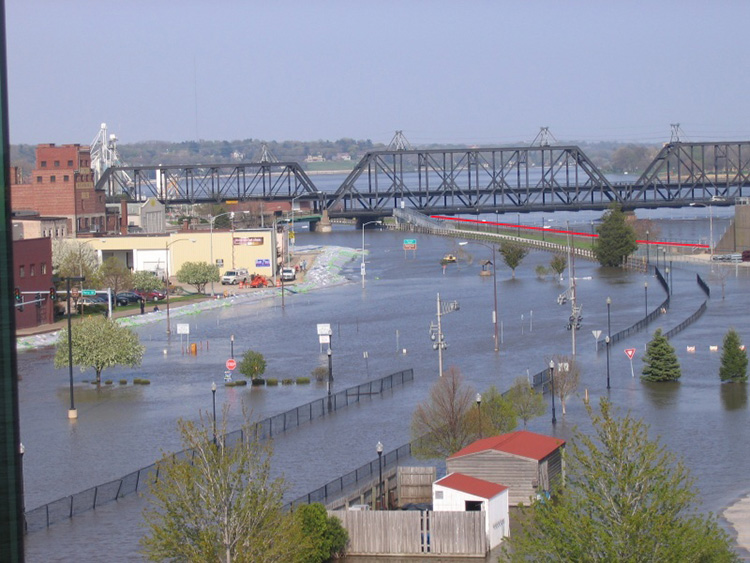
Iowa preppers face many of the same threats as anyone else in America: civil collapse, EMP, natural disasters, etc. However, Iowans have unique challenges than preppers in other states. What makes sense for a prepper in Alaska may not make sense for a prepper in Illinois.
This applies to Iowa as well. This article will focus on Iowa from a prepper’s perspective. What specific challenges does the state face from a historical perspective? What are the threats given the state’s geography? Where should Iowans prioritize their preps?
NOTE: Do you live in Iowa? You know your state, so let us know in the comments section how this article can be improved. What did we miss? What did we get right?
Iowa Overview – Prepper’s Perspective
Nicknamed the “The Hawkeye State,” Iowa should probably be renamed “the flat state” as the geography defines everything about it. Iowa is extremely flat. A quick glance at an elevation map will show that Iowa only has slight variances in its terrain in the northwest corner. The rest of the state is as flat as anyone could imagine and dotted with water.
Iowa has some of the richest soil in the US, appropriately making it an agricultural powerhouse. With more than 30 million acres of farmland and over 92,000 farms, Iowa’s total agricultural-related economic output is over $112 billion. As a result, agriculture is responsible for 1 out of every 5 jobs. An average Iowan farmer feeds 154 people. This accounts for the state suppling 7% of the country’s food.
However, that does not mean that Iowa is behind the times. Iowa’s agriculture industry has embraced green energy, resulting in the state being 1st in the production of renewable fuels such as biodiesel. They also rank 1st in the use of wind-generated electricity for agriculture. This modern approach to life has allowed Iowa to routinely be a political and economic powerhouse.
For example, the state’s biggest industry by dollar amount is manufacturing. Iowa production plants employ more than 200,000 people. This contributes more than $25 billion per year to the statewide gross domestic product. While only a fraction of the agricultural sector, it is still noteworthy.
Iowa sits squarely in the middle of six states. Illinois, Nebraska, Minnesota, Missouri, Wisconsin, and South Dakota share borders with Iowa and routinely trade there. Only being the 31st most populous state in the country, Iowans enjoy being spread out away from one another.
Climate
Iowa has a distinct four-season climate. While this can make it challenging for some, others will rejoice in the cold winters and warm and humid summers. The general understanding of Iowa is a cold, wintery farmland in the heart of America. While the winters will average a cold, 14 degrees F many do not know that the summers are quite warm. Summers in the Hawkeye state can average a swelteringly humid 80 degrees F.
In keeping with the agricultural theme of the state, it gets plenty of rain. The annual average rainfall ranges from 26 inches in the northwest, to more than 38 inches in the southwest. While this is excellent for farming, it can be quite devastating for those under threat of floods. In fact, Iowa is extremely prone to floods and tornados since it is so flat.
Food and Water
Given the flat farmland that makes up the entire state of Iowa, it is no surprise that the state is a food powerhouse for America. The most impressive fact about Iowa’s food production is not just the quantity, but the diversity built into their production. Iowa leads the nation in the production of corn, soybeans, pork, and eggs. While it would be expected for such an agriculturally bent state to be a food producer, the fact that they can lead with so many different products is truly exceptional.
In Iowa, there is never a water shortage. Between the Raccoon and Des Moines Rivers, the state’s primary sources of water, there is plenty of water for agriculture, recreation, and life. The Jordan aquifer, along with other aquifers, rivers, and lakes afford the residents of Iowa plenty of opportunity to have their own well and enjoy being independent.
Politics
The politics of Iowa are well known across the nation. They take pride and enjoy being the first state to caucus early in the presidential election season. If the presidential election was a sports season, the Iowa caucus is the opening game. However, to be so enthusiastic about politics, Iowa does not have much political diversity. Likely due to the rural nature of the state, Iowa is very red. The state is staunchly conservative with the sitting governor and senators all members of the Republican party.
Population
Iowa has a very white, very traditional population. Out of the population of 3.2 million people, 85.7% are White. With a large migratory worker population to supplement farm labor, it is not surprising that the Hispanic population makes up the second largest population group at 6%. Other populations are Black with 3.6%, Asians with 2.4%, and other races 1.9%. American Indians only comprise 0.3% of the total population.
The residents of Iowa are fairly evenly divided between the sexes. Women hold the majority making up 50.4% and men making up 49.6%. The average Iowan is 38.5 years old which is older that the average American. This could also help explain the conservative politics of the state as older populations generally skew to that end of the political spectrum.
Another interesting fact of the Iowan population is that only 54.5% of Iowans identify as religious. Out of this population, the majority identify as part of the Christian faith. Given its rural nature and its conservative politics, it would stand to reason that Iowans were far more religious than what they actually are. While the bent toward Christianity is not surprising, the fact that nearly half of the population declares no religious affiliation is astounding.
Crime
Iowa is a very safe place to live in terms of crime. While there are many maladies that could happen to a prepper in Iowa, it will likely not come at the hands of fellow residents. The chances of being the victim of a violent crime in Iowa is 1 in 332. The murder rate is below the national average at 0.03 per 1000 people. The assault rate is also below the national average at 2.27 per 1000 people. This translates to a very quiet and safe environment that is likely propped up by its rural nature.
Property crime is also incredibly low. The robbery rate is far below the national average at 0.30 per 1000 people. Your chances of becoming the victim of a property crime are 1 in 58. The burglary rate is slightly above the national average at 3.68 per 1000 people. However, both the theft and motor vehicle theft rates are below the national average. These statistics make sense when you consider that the population of Iowa is very evenly dispersed both economically and geographically. Both of which discourage property crime as it is inconvenient and unnecessary.
Iowa Natural Disasters
Given the rainfall, flat terrain, and large quantities of water, it is no surprise that Iowa is prone to major floods. Tornadoes also torment the state with an average of 48 tornadoes annually. Other natural disasters include storms, winter storms, landslides, extreme heats and droughts, and power outages. However, nothing compares to the destruction brought on by the floods and tornados the state experiences.
Here in the land of the corn, floods and blizzards are the primary disasters to be wary of. Make sure you have warm clothes, a wood stove, and an evacuation plan in place should widespread flooding hit your area!
1) The Armistice Day Blizzard (1940) – Killing 150 people, this blizzard was truly lethal. Dropping more than a foot of snow throughout Iowa, and combined with 45mph winds, this storm absolutely covered the state. Duck hunters later noted it had been a fantastic hunting weekend the few days before the storm. This came about as the ducks were attempting to outrun the blizzard. Today, there are systems in place to prevent much of the devastation and loss of life that were experienced during this storm, but it is an example that we should all be aware of.
2) The 1965 Mississippi River Flood – The Mississippi River has a well earned reputation for overflowing and creating havoc along its banks. In 1965 it did that and more. With a death rate of 14 people and $125 million in damages, the Mississippi River Flood of 1965 is legendary in the state of Iowa. Despite the best efforts of multiple agencies and never ending work of locals, the flood was still able to drown those that could not get out of its path.
3) The Blizzard of 1973 – While Iowa is well known for its harsh winters, the Blizzard of 1973 came in the early spring. With snow drifts as high as 12 feet in some places, this freak April blizzard left Iowa buried under tons of snow. Combined with 70mph winds, this made for one brutal winter storm. A total of 14 people were killed in this storm, though most of them occurred due to heart attacks. This speaks to the fragility of the public infrastructure during natural disasters as many simply could not get the medical care they needed.
4) The Great Flood of 1993 – In 1993 Iowa nearly drowned as record rainfall effectively shut down much of the state. One of the most notable infrastructure failures was the loss of water to a quarter of a million residents. As the flood waters raised the level of the Des Moines river, the Des Moines Water Works could simply not keep up. Ironically, the processing plant was shut down and water was cut off. This flood sent 10,000 people running for the hills, destroyed/damaged 21,000 homes, killed 17, and caused $2.7 billion in damage.

5) The 2008 Flood – While actually much worse than the 1993 flood, the 2008 flood was less lethal thanks to lessons learned two decades earlier. River levels this year actually beat those of 1993 resulting in almost 100% of Iowa’s counties declared a Federal Disaster Area. While there was a record $10 billion in damages, only one person died. This is a testament of studying past disasters and implementing plans and preparations that are informed by lessons learned.

6) The 2008 Tornado Outbreak – Along with record floods, multiple tornadoes struck at the same time in 2008. The most notable was the ¾ mile wide EF5 that made its way through Northern Iowa. While tornados are extremely common in Iowa, they are almost never this destructive. With a destructive path that is 43 miles long and many people dead as two cities were completely destroyed, the 2008 Tornado Outbreak is a cautionary tale of what the weather of Iowa is capable of.
Iowa Challenges
Luckily, the main challenge in Iowa is a result of weather and not humans. This is fortunate as weather is predictable in both its occurrences and actions. Therefore, the main challenge to a prepper in Iowa is not what to do during a natural disaster, but how to effectively prepare for it well in advance.
No matter if you find yourself bugging out during a flood or bugging in during a blizzard, the key to prepping in the state of Iowa is to be prepared for the long haul. Being able to meet your own needs and the needs of your family for an extended period of service disruption is crucial to success.
Iowa Prepping Strategies
Iowa has fairly standard challenges for the prepper. For the most part, standard prepping strategies and prepper supplies will serve Iowans well.
Bugging In
Produce Your Own Heat
One of the reoccurring natural disasters that stops Iowa in its tracks are blizzards. While blizzards knock out power, shut down roads, and isolate people, their most destructive feature is the wind and cold. In the event that power and gas no longer work, it would be very easy to freeze to death during one of these storms. Therefore, the prudent prepper will have a wood burning stove of some sort ready to go at a moments notice. Having at least two chords of wood readily available to supply the stove with is a requirement for survival during one of Iowa’s epic blizzards.
Sandbags
Floods are another common occurrence that routinely plagues the flat, wet state of Iowa. With heavy rainfalls and saturated ground, the springs of Iowa have proven to be deadly. What’s worse, they may yet again. One of the simplest things a prepper can do to defend their home against flood is to have sandbags ready for use and having free sand to make use of them.
- Heavy Duty - Tapix Multipurpose White Sandbags are made of premium quality polypropylene. Double sewn in the bottom for extra strength. These polypropylene sandbags makes sure to hold the sand or the...
- Multipurpose - These empty sand bags are used in many ways. Mostly for flood protection and construction projects. It is designed to be water-resistant and dust-resistant. Sandbags for flooding is...
- UV Resistant - These small sandbags will most likely to be out in the sun for days and hours. Our bags of sand are designed to have up to 1600 hours of UV protection against the sun.
- Affordable Hurricane Solution - If you’re looking for saving some money, hurricane sandbags are affordable and reusable. Use the flood bags for temporary barricades for construction projects. The...
Building walls to divert water and to shore up their home comes at the cost of a small stack of plastic bags in their basement. While filling them can be a grueling workout, there is no reason not to have them on hand. When floodwaters rise, it is important to have the right tools to respond quickly and effectively.
Medical
Tornados, blizzards, and floods all have the same thing in common, the disruption of modern life. While we review the commonalities of those that lost their lives during these disasters, one recurring theme is the lack of access to medical care during the event. When there are feet of snow or water covering your house, the ambulance is not coming to save you in any reasonable time period.
Therefore, a prepper should have all the training and medical equipment needed to render aid to themselves and their family until order is restored. This means having a good first aid bag, a defibrillator, and knowing how to use it. At a minimum Iowans should have a copy of Where There Is No Doctor as a medical guide.
Bugging Out
One of the most important pieces of equipment for any prepper planning to bug out is to have decent maps of their state. Having an identified bug out location is crucial. All preppers in any state should begin their bug out plans with a paper map of their state. Nothing is better for all-purpose use than the DeLorme Atlas and Gazetteer.
- Includes Back roads, elevation contours, recreational areas, etc.
- Paperback for easy carry and storage
- Easy to use and read
- DeLorme (Author)
A Boat
We have all seen the videos and pictures of small boats driving past street signs during floods. That is a picture of someone who was prepared as opposed to someone that was a victim. Having a small boat will not only give you options of where to go, but it is one of the tools in a preppers kit that provides enjoyment during happier times. Purchase a small boat that can get you to high ground during a flood and give you access to fishing holes when the river isn’t overflowing its banks.
Ham Radio
When the power is out, there is no internet, radio, or TV. In order to get information about where to go or what to avoid, you will need some sort of handheld or vehicle born Ham radio. During disasters, ham radio operators regularly transmit and exchange information across emergency radio frequencies about conditions on the ground as they happen.
No products found.
Having a ham radio in your bug out bag or vehicle is critical to getting information that will help you make the right decision when the time comes.
Count Calories for the Long Haul
No one will be able to get to you in the event of a flood or a blizzard. It is critical that you be able to take care of yourself for an extended period of time. Flood waters can last for an extended period of time and if you are traversing the state seeking dry ground, you will need to be able to survive. Think through the food in your bug out bag. Make sure that the calorie to weight ratio is sufficient for you and your family.
Further Reading for Iowa Preppers
This article just scratches the surface of what Iowa preppers need to know. The following links could held educate you more on prepping in the state.
Iowa Preppers– Facebook group that is focused on Iowa, posts semi-regularly.
Iowa Ham Radio Club– Radio club for Iowa residents to connect via Ham radio.
Iowa Preparedness Supply– Offers classes in prepping as well as supplies to the general public.
Wild Iowa– Curated adventures to help attendees learn how to survive in the wild of Iowa.
Iowa Camps and Workshops– Government compiled list of educational camps on survival and outdoors.
Iowa Disaster Recovery– State Government disaster response page with information on current events and efforts.


